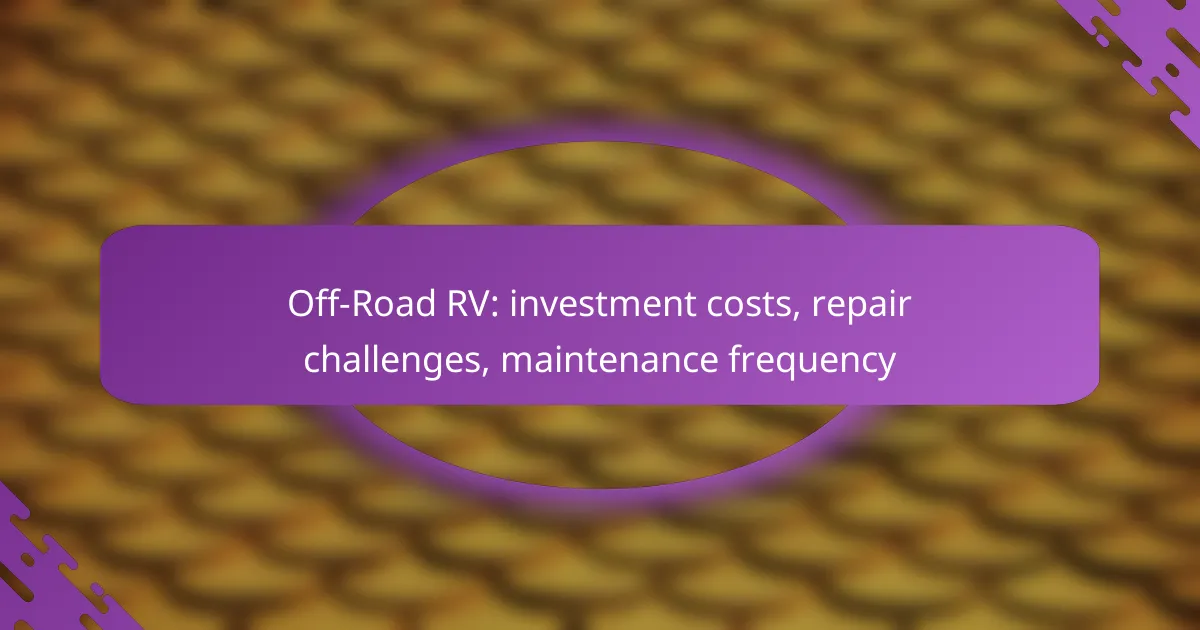Investing in an off-road RV involves careful consideration of various costs, including the purchase price, financing, and ongoing expenses like insurance and registration. These vehicles are designed for rugged use, which can lead to unique repair challenges, such as mechanical failures and sourcing replacement parts. To ensure optimal performance and longevity, regular maintenance every 3 to 6 months is essential, helping to prevent costly repairs down the line.

What are the investment costs for Off-Road RVs in Canada?
The investment costs for off-road RVs in Canada can vary significantly based on the model, features, and additional expenses. Prospective buyers should consider not only the purchase price but also financing, insurance, registration, and long-term value retention when budgeting for their off-road RV.
Initial purchase price
The initial purchase price of off-road RVs in Canada typically ranges from CAD 20,000 to CAD 100,000 or more, depending on the brand, size, and amenities. Entry-level models may be more affordable, while high-end options with advanced features can be significantly pricier. It’s essential to factor in the cost of any necessary modifications for off-road capability.
Financing options
Financing options for off-road RVs include traditional loans, dealership financing, and personal loans. Many dealerships offer financing plans that can range from 3 to 15 years, with interest rates varying widely based on credit scores. It’s advisable to shop around for the best rates and terms to minimize long-term costs.
Insurance expenses
Insurance expenses for off-road RVs can vary based on factors such as the RV’s value, the owner’s driving history, and the coverage level chosen. On average, owners may pay between CAD 800 and CAD 2,000 annually for comprehensive coverage. It’s important to compare quotes from multiple insurance providers to find the best coverage at a competitive price.
Registration and licensing fees
Registration and licensing fees for off-road RVs in Canada depend on the province and the vehicle’s weight. Typically, these fees can range from CAD 100 to CAD 300 annually. Some provinces may also require additional inspections or permits for off-road use, so checking local regulations is essential.
Long-term value retention
Long-term value retention for off-road RVs can be influenced by factors such as brand reputation, condition, and market demand. Generally, well-maintained RVs can retain around 50% to 70% of their value after five years. To maximize resale value, regular maintenance and timely repairs are crucial, along with keeping detailed service records.
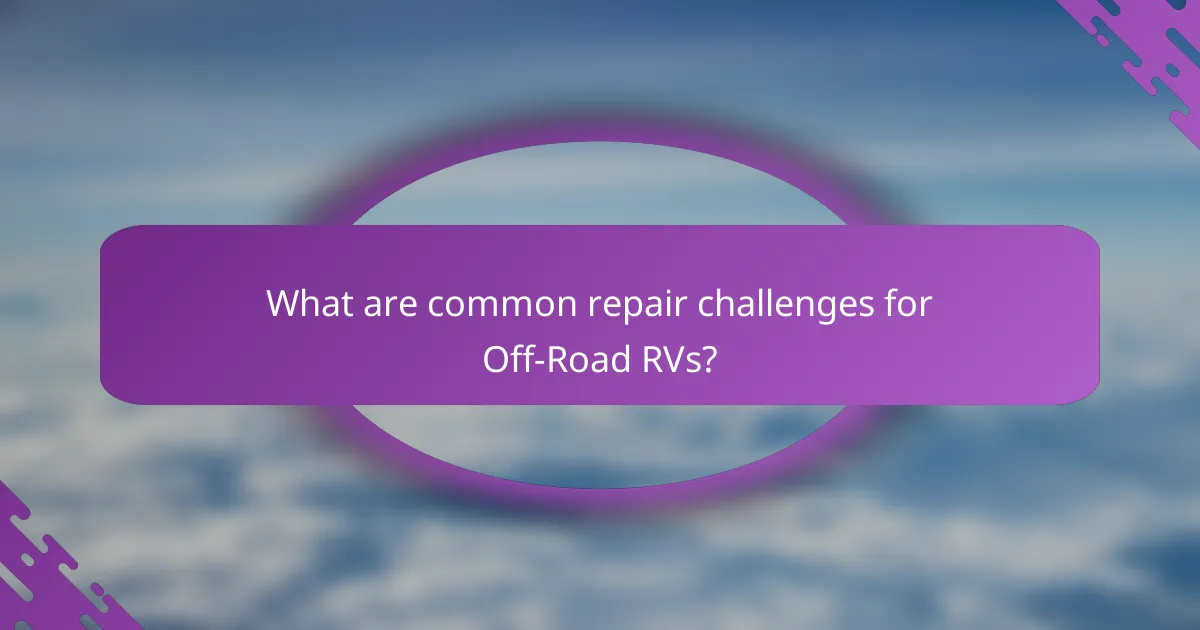
What are common repair challenges for Off-Road RVs?
Off-road RVs face unique repair challenges due to their rugged use and exposure to harsh environments. Common issues include mechanical failures, electrical system problems, body and frame damage, and difficulties in sourcing replacement parts.
Mechanical issues
Mechanical issues in off-road RVs often stem from the demanding conditions they operate in, such as rough terrain and extreme weather. Components like the suspension, drivetrain, and brakes may wear out faster than in standard RVs. Regular inspections and maintenance can help identify potential problems before they escalate.
It’s advisable to keep an eye on fluid levels and listen for unusual noises while driving. Addressing minor mechanical issues promptly can prevent costly repairs later on.
Electrical system failures
Electrical system failures are common in off-road RVs due to exposure to dust, moisture, and vibrations. Problems can arise in the battery, wiring, and appliances, leading to power loss or malfunctioning systems. Regular checks of the electrical connections and battery health can mitigate these risks.
Consider investing in protective covers for sensitive components and ensuring that all wiring is properly secured to reduce the likelihood of damage during off-road excursions.
Body and frame damage
Body and frame damage can occur from collisions with rocks, trees, or other obstacles while off-roading. This damage can compromise the structural integrity of the RV, making timely repairs essential. Inspect the body and frame regularly for dents, cracks, or rust, especially after intense trips.
Using protective coatings and bumpers can help minimize damage. If repairs are needed, addressing them quickly can prevent further deterioration and maintain safety.
Parts availability
Sourcing replacement parts for off-road RVs can be challenging due to their specialized nature. Not all parts may be readily available at local stores, and some may require ordering from manufacturers or specialty suppliers. It’s wise to keep a list of essential parts and their suppliers handy for quick access when repairs are needed.
Consider joining online forums or local clubs where fellow off-road RV enthusiasts share resources and recommendations for reliable parts suppliers. This can save time and ensure you have access to the right components when necessary.
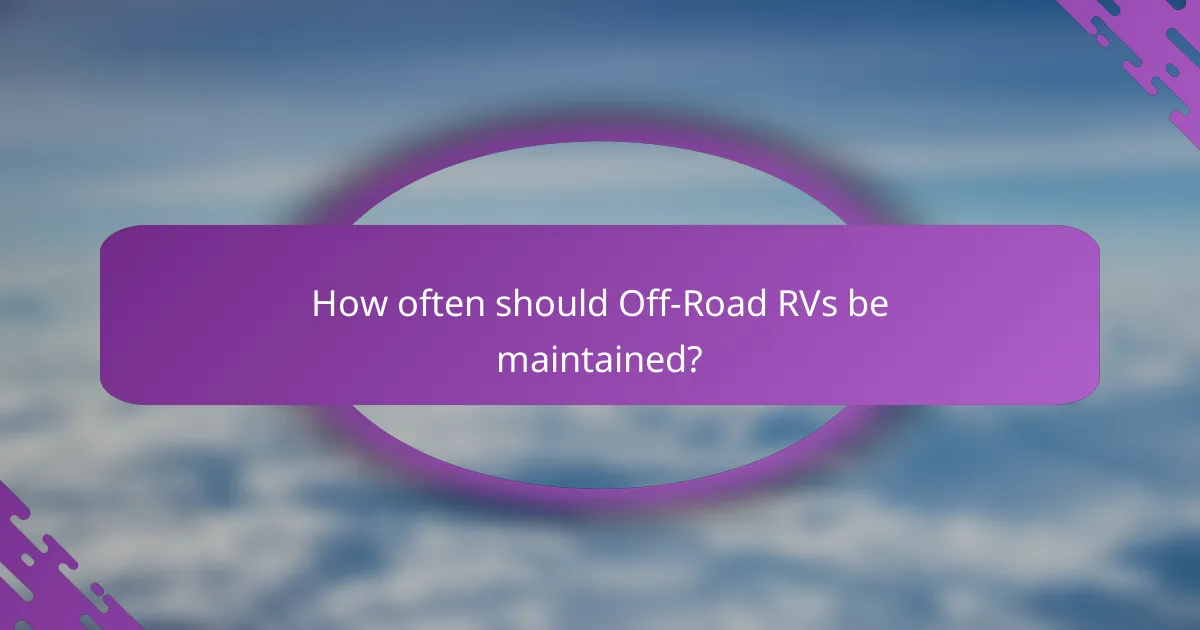
How often should Off-Road RVs be maintained?
Off-road RVs should be maintained regularly to ensure safety and performance, typically every 3 to 6 months, depending on usage and conditions. Regular maintenance helps prevent costly repairs and extends the lifespan of the vehicle.
Recommended maintenance schedule
A recommended maintenance schedule for off-road RVs includes checking essential systems every 3 months and performing more comprehensive inspections every 6 months. Key areas to focus on include the engine, brakes, tires, and suspension. Keeping a log of maintenance activities can help track when specific services are due.
For those who use their RVs frequently, consider a monthly check of fluid levels and tire pressure to catch any issues early. Seasonal changes may also dictate adjustments to the schedule, especially if the RV is stored for extended periods.
Seasonal maintenance tasks
Seasonal maintenance tasks are crucial for off-road RVs, particularly before and after heavy usage periods. In spring, inspect the roof for leaks, clean the undercarriage, and check the battery and electrical systems. In fall, focus on winterizing the plumbing system to prevent freezing and damage.
Additionally, inspect the tires for wear and ensure they are properly inflated for off-road conditions. Regularly cleaning and sealing the exterior can protect against the elements and prolong the life of the RV.
Importance of regular inspections
Regular inspections are vital for maintaining the safety and reliability of off-road RVs. These checks can identify potential issues before they escalate into major repairs, saving time and money. Look for signs of wear on critical components like brakes and suspension systems.
Establishing a routine inspection process can help ensure that all systems are functioning correctly. Consider documenting findings and repairs to create a comprehensive maintenance history, which can be beneficial for resale value and warranty claims.
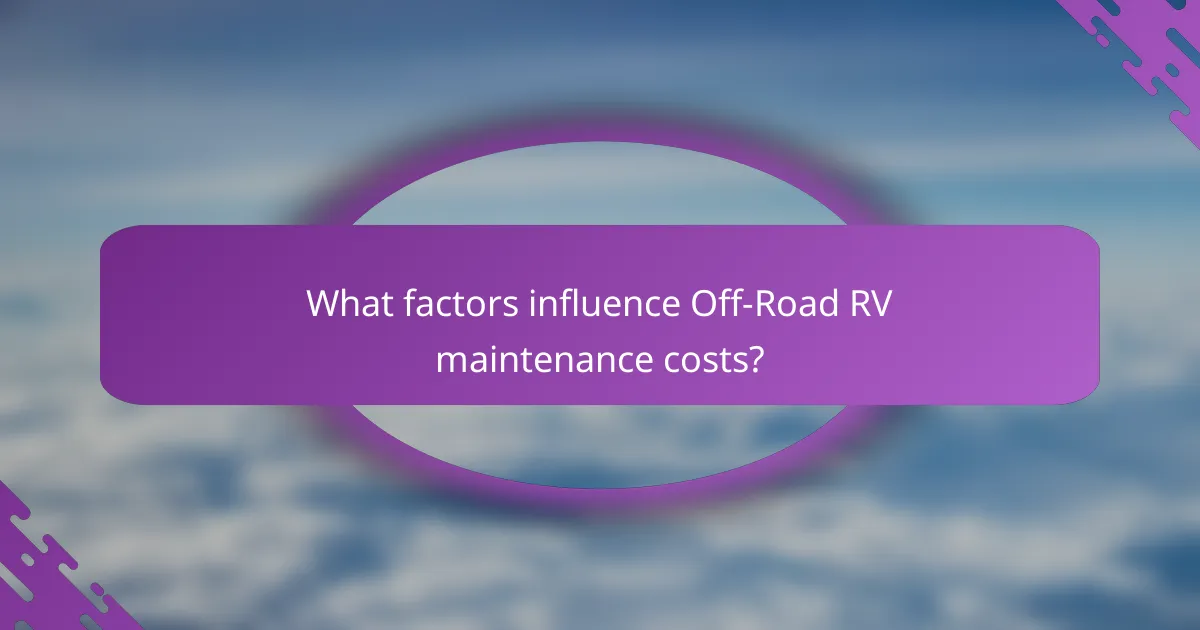
What factors influence Off-Road RV maintenance costs?
Off-Road RV maintenance costs are influenced by several key factors, including the type of RV model, the age of the vehicle, and how frequently it is used. Understanding these elements can help owners anticipate expenses and plan for necessary upkeep.
Type of RV model
The type of off-road RV model significantly impacts maintenance costs. High-end models with advanced features may require specialized parts and services, leading to higher expenses. In contrast, more basic models might have lower maintenance costs due to simpler designs and readily available parts.
Additionally, certain brands are known for their durability and lower upkeep needs, while others may have a reputation for frequent repairs. Researching model-specific reviews can provide insights into expected maintenance costs.
Age of the vehicle
The age of an off-road RV plays a crucial role in determining maintenance costs. Older vehicles often require more frequent repairs and replacements of worn-out components, which can add up over time. As a general rule, maintenance needs tend to increase significantly after the first five to ten years of ownership.
Owners of older RVs should budget for potential upgrades or replacements of key systems, such as the suspension or electrical systems, which may become outdated or fail. Regular inspections can help identify issues early, potentially saving money in the long run.
Usage frequency
How often an off-road RV is used directly affects maintenance costs. Frequent use can lead to quicker wear and tear on essential components, resulting in higher repair bills. RVs that are used for extended trips or harsh terrains may require more rigorous maintenance compared to those used occasionally.
To manage costs, owners should establish a regular maintenance schedule based on usage patterns. For example, RVs used heavily might need checks every few months, while those used less frequently could be serviced annually. Keeping a detailed log of maintenance activities can help track expenses and predict future needs.
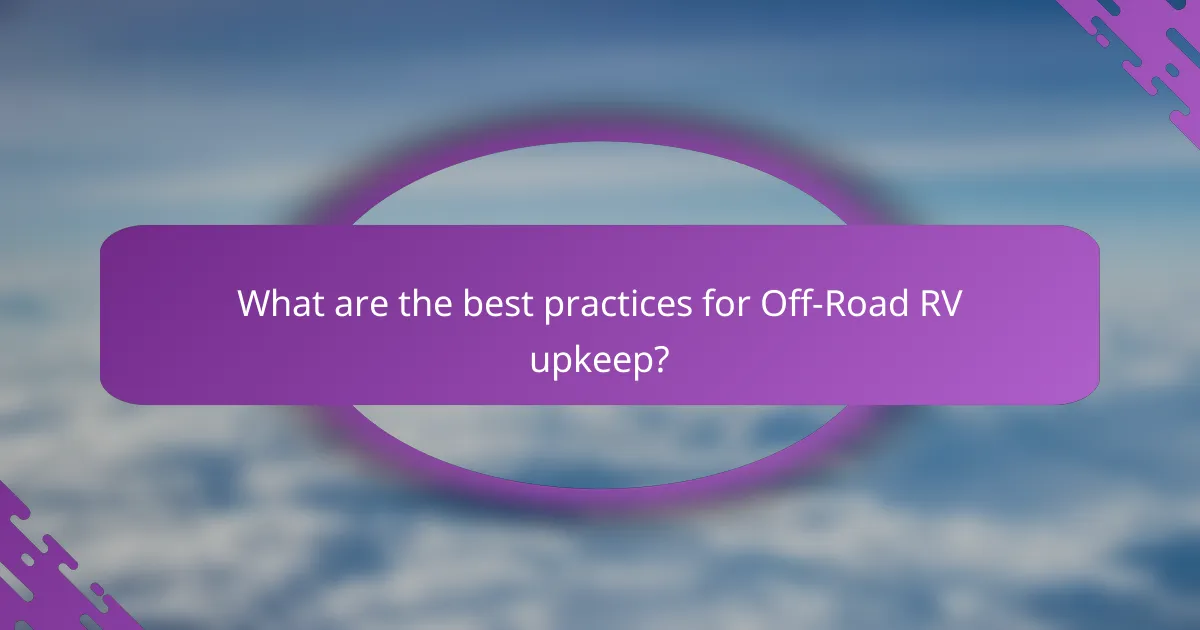
What are the best practices for Off-Road RV upkeep?
Maintaining an off-road RV involves regular inspections, cleaning, and repairs to ensure longevity and performance. Adopting best practices can help prevent costly repairs and enhance your outdoor experiences.
Routine cleaning techniques
Routine cleaning is essential for off-road RV upkeep, as it helps prevent dirt and grime buildup that can lead to corrosion and mechanical issues. Start with a thorough wash of the exterior using a gentle soap and water solution, ensuring you reach all nooks and crannies.
For the interior, vacuum regularly and wipe surfaces with appropriate cleaners to remove dust and moisture. Pay special attention to areas prone to mold, such as bathrooms and kitchens, by using mildew-resistant products.
Consider using a protective wax or sealant on the exterior to shield against UV rays and dirt accumulation. Regularly check and clean the undercarriage, as off-road conditions can lead to mud and debris buildup that may affect performance.
